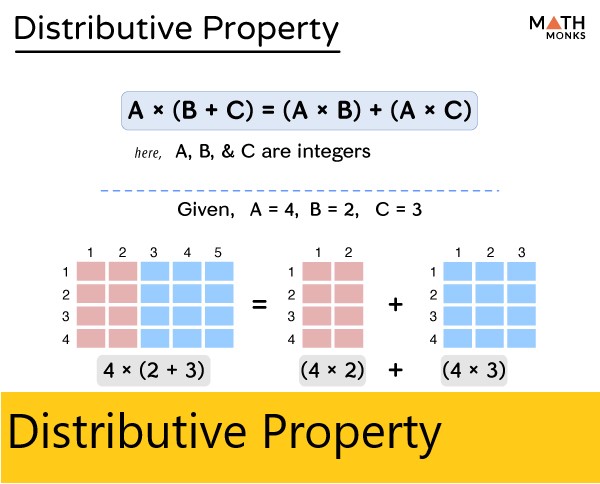Distributive Property
Distributive Property – The distributive property is also known as the distributive law of multiplication over addition and subtraction. The name itself signifies that the operation includes dividing or distributing something. The distributive law is applicable to addition and subtraction. Let us learn more about the distributive property of multiplication along with some distributive property examples, how to use the distrivutive property on this page.
What is the Distributive Property?
The distributive property states that an expression which is given in form of A (B + C) can be solved as A × (B + C) = AB + AC. This distributive law is also applicable to subtraction and is expressed as, A (B – C) = AB – AC. This means operand A is distributed between the other two operands.
Distributive Property Definition
According to the distributive property definition, the distributive property allows us to take a factor and distribute it to each member (term) of the group of things that have been added or subtracted. Instead of multiplying the factor by the group as a whole, we can distribute it to be multiplied by each member (term) of the group individually.
Distributive Property Formula
The distributive property formula of a given value is expressed as,
Let us discuss the distributive property of multiplication over addition and subtraction in detail with examples.
Distributive Property of Multiplication Over Addition
The distributive property of multiplication over addition is applied when we need to multiply a number by the sum of two numbers. For example, let us multiply 7 by the sum of 20 + 3. Mathematically we can represent this as 7(20 + 3).
Example: Solve the expression 7(20 + 3) using the distributive property of multiplication over addition.
Read More : Mypass-a-grille.com

Solution: When we solve the expression 7(20 + 3) using the distributive property, we first multiply every addend by 7. This is known as distributing the number 7 amongst the two addends and then we can add the products. This means that the multiplication of 7(20) and 7(3) will be performed before the addition. This leads to 7(20) + 7(3) = 140 + 21 = 161.
Distributive Property of Multiplication Over Subtraction
The distributive property of multiplication over subtraction is similar to the distributive property of multiplication over addition except for the operation of addition and subtraction. Let us consider an example of the distributive property of multiplication over subtraction.
Example: Solve the expression 7(20 – 3) using the distributive property of multiplication over subtraction.
Solution: Using the distributive property of multiplication, we can solve the expression as follows: 7 × (20 – 3) = (7 × 20) – (7 × 3) = 140 – 21 = 119
Verification of Distributive Property
Let us try to justify how distributive property works for different operations. We will apply the distributive law individually on the two basic operations, i.e., addition and subtraction.
Distributive Property of Addition: The distributive property of multiplication over addition is expressed as A × (B + C) = AB + AC. Let us verify this property with the help of an example.
Example: Solve the expression 2(1 + 4) using the distributive law of multiplication over addition.
Solution: 2(1 + 4) = (2 × 1) + (2 × 4)
⇒ 2 + 8 = 10
Now, if we try to solve the expression using the law of BODMAS, we will solve it as follows. First, we will add the numbers given in brackets, and then we will multiply this sum with the number given outside the brackets. This means, 2(1 + 4) ⇒ 2 × 5 = 10. Therefore, both the methods result in the same answer.
Distributive Property of Subtraction: The distributive law of multiplication over subtraction is expressed as A × (B – C) = AB – AC. Let us verify this with the help of an example.
Example: Solve the expression 2(4 – 1) using the distributive law of multiplication over subtraction.
Solution: 2(4 – 1) = (2 × 4) – (2 × 1)
⇒ 8 – 2 = 6
Now, if we try to solve the expression using the order of operations, we will solve it as follows. First, we will subtract the numbers given in brackets, and then we will multiply this difference with the number given outside the brackets. This means 2(4 – 1) ⇒ 2 × 3 = 6. Since both the methods result in the same answer, this distributive law of subtraction is verified.
Distributive Property of Division
We can show the division of larger numbers using the distributive property by breaking the larger number into two or more smaller factors. Let us understand this with an example.
Example: Divide 24 ÷ 6 using the distributive property of division.
Solution: We can write 24 as 18 + 6
24 ÷ 6 = (18 + 6) ÷ 6
Now, let us distribute the division operation for each factor (18 and 6) in the bracket.
⇒ (18 ÷ 6) + (6 ÷ 6)
⇒ 3 + 1
Therefore, the answer is 4.
Cuemath is one of the world’s leading math learning platforms that offers LIVE 1-to-1 online math classes for grades K-12. Our mission is to transform the way children learn math, to help them excel in school and competitive exams. Our expert tutors conduct 2 or more live classes per week, at a pace that matches the child’s learning needs.
